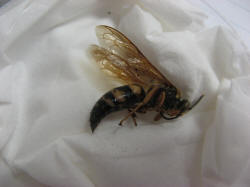|
 Green June bugs, cicada killer wasps and lawn rust Green June bugs, cicada killer wasps and lawn rust
By John
Fulton
 Send a link to a friend
Send a link to a friend
[July 07, 2010]
A large, green beetle that sounds like a
bumblebee when it flies has emerged in the last week. No, it isn't a
Japanese beetle on steroids. It is a green June bug. These insects
also have a grub stage but are not usually pests. They tend to lay
eggs in places high in organic matter, such as flower beds, under
shrubs, in compost piles, gardens and manure piles. The adult beetle
can cause damage to soft fruits such as grapes, peaches, apricots
and plums. It is actually called a fig eater overseas. Products such
as bifenthrin, permethrin and Sevin are effective in controlling the
adults. Remember, under hot conditions, products such as permethrin
and bifenthrin may last for only a few days.
|
 Cicada
killer
wasps Cicada
killer
waspsThe cicada killer wasps will return shortly. They
are actually considered beneficial insects because they control
cicadas and katydids. This wasp gets its common name due to the
fact that it hunts and supplies its nest chambers with a cicada,
which becomes a food source for the young wasp. Cicada killers
are a nuisance pest, especially when nesting in large numbers in
a play area or near the house. People get concerned because the
cicada killers resemble giant yellow jackets.

Cicada killers are about 2 inches long and black to red, with
yellow-banded markings on the abdomen. The head and transparent
wings are reddish-brown. They are not dangerous, but they are
intimidating.
Cicada killers are solitary wasps, with the female digging a
6- to 10-inch burrow (one-half inch in diameter) in the ground.
A pile of soil typically surrounds the entrance. The female
locates and stings a large insect such as a cicada or katydid
and then brings it back to the burrow. She places the insect
into a chamber and lays an egg on it; sometimes she puts two in
a burrow but lays an egg on only one. She then covers the
burrow, digs another and repeats the process. The egg hatches
into a grublike, legless larva that consumes the paralyzed
insect. Full-grown larvae overwinter in the burrow, pupate in
the spring and emerge as adults during the summer, usually in
July and August.
[to top of second column]


|
 Cicada killers are unlikely to sting a person. Wasp and bee
stingers are modified egg-laying devices (ovipositors), so males are
not able to sting. Females may sting if crushed, either by being
stepped on with bare feet or grabbed with bare hands. Treatment of
burrowing areas with a pyrethroid insecticide or carbaryl (Sevin)
may reduce problems.
Lawn rust
As grass growth slows, rust will be one of the lawn fungi we are
dealing with. Rust appears as an orange or yellowish-orange powder
(spores) on grass leaf blades, especially in late summer to early
fall when the weather is dry. Rust typically develops on lawns
growing very slowly. Overall, the turf may assume a yellow, red or
brown appearance. Rust spores can easily be tracked into homes.
Other turf diseases, such as dollar spot and brown patch, are also
prevalent.
Low fertility (in particular nitrogen) and high temperatures slow
down turf growth, allowing rust to develop. Heavy dew and light,
frequent rainfall add to the ideal conditions for rust to develop.
Warm, cloudy, humid weather followed by hot, sunny weather also
favors rust development on lawns. Kentucky bluegrass, perennial
ryegrass and tall fescue are all affected, depending on cultivars.
Rust spreads through air, water, shoes, equipment and sod. Rust may
weaken turf grasses and make them more susceptible to other
problems. Fungicides are rarely suggested on home lawns for rust
control. Focus on the listed cultural practices described above.
[By
JOHN FULTON,
University of Illinois Extension, Logan County]
 |